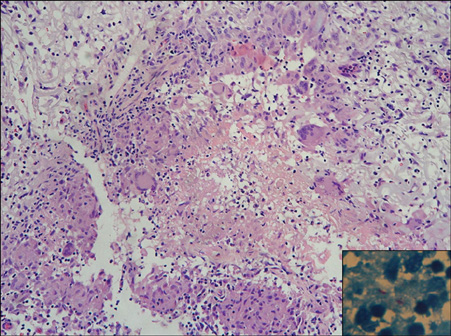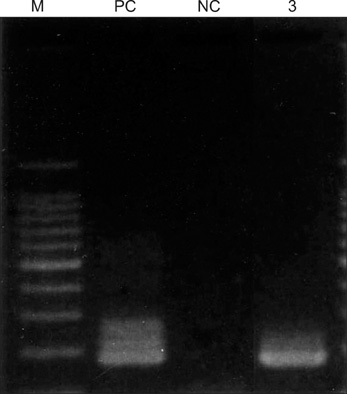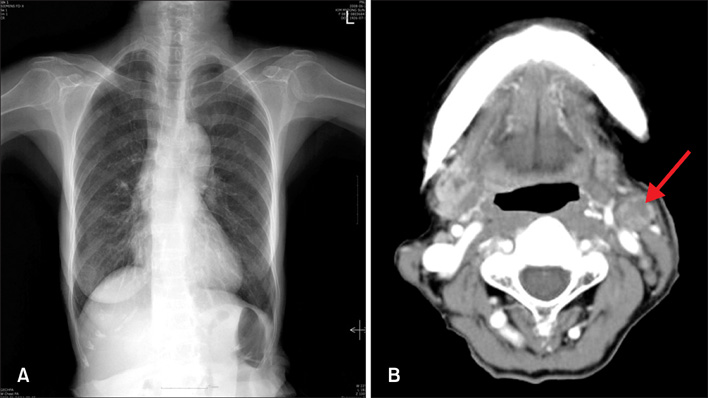Ann Dermatol.
2012 Feb;24(1):70-73. 10.5021/ad.2012.24.1.70.
Delayed Diagnosis of Scrofuloderma Misdiagnosed as a Bacterial Abscess
- Affiliations
-
- 1Department of Dermatology, School of Medicine, Pusan National University, Busan, Korea. drkmp@hanmail.net
- 2Medical Research Institute, Pusan National University, Busan, Korea.
- 3Department of Beauty Care, College of Health, Social Welfare and Education, Tongmyong University, Busan, Korea.
- KMID: 2156859
- DOI: http://doi.org/10.5021/ad.2012.24.1.70
Abstract
- An 82-year-old woman presented with a four-month history of an ulcerative plaque overlying her left neck. This lesion had developed as a subcutaneous nodule, gradually increased in size, and evolved into ulcers. Before visiting our Dermatology clinic, the patient had been diagnosed as having a bacterial abscess, but treatments with antibiotics were unsuccessful. The presence of a purulent discharge and prominent ulceration caused further confusion as bacterial abscess, and radiologic evaluation on computed tomography also led to the possibilities of secondary lesions from an abscess or malignancy. However, the characteristic appearance of her lesion allowed us to discern cutaneous tuberculosis, especially scrofuloderma. Based on clinical examinations, staining for acid-fast bacilli, and positive findings of polymerase chain reaction, a quick diagnosis of scrofuloderma was made. After that, she was treated successfully with anti-tuberculosis therapy and the ulcer healed. Our case highlights the problem of delayed diagnosis of scrofuloderma presenting as a bacterial abscess. In conclusion, having a high index of suspicion is needed to diagnose cutaneous tuberculosis correctly.
Keyword
MeSH Terms
Figure
Reference
-
1. Lantos G, Fisher BK, Contreras M. Tuberculous ulcer of the skin. J Am Acad Dermatol. 1988. 19:1067–1072.
Article2. Tappeiner G. Wolff K, Goldsmith LA, Katz SI, Gilchrest BA, Paller AS, Leffell DJ, editors. Tuberculosis and infections with atypical mycobacteria. Fitzpatrick's dermatology in general medicine. 2008. 7th ed. New York: McGraw-Hill Medical;1768–1778.3. Barbagallo J, Tager P, Ingleton R, Hirsch RJ, Weinberg JM. Cutaneous tuberculosis: diagnosis and treatment. Am J Clin Dermatol. 2002. 3:319–328.4. Sehgal VN, Wagh SA. Cutaneous tuberculosis. Current concepts. Int J Dermatol. 1990. 29:237–252.5. Kivanç-Altunay I, Baysal Z, Ekmekçi TR, Köslü A. Incidence of cutaneous tuberculosis in patients with organ tuberculosis. Int J Dermatol. 2003. 42:197–200.
Article6. Yates VM, Ormerod LP. Cutaneous tuberculosis in Blackburn district (U.K.): a 15-year prospective series, 1981-95. Br J Dermatol. 1997. 136:483–489.
Article7. Tan WP, Tang MB, Tan HH. Scrofuloderma from the acromioclavicular joint presenting as a chronic ulcer in an immunocompetent host. Singapore Med J. 2007. 48:e243–e245.8. Hsiao PF, Tzen CY, Chen HC, Su HY. Polymerase chain reaction based detection of Mycobacterium tuberculosis in tissues showing granulomatous inflammation without demonstrable acid-fast bacilli. Int J Dermatol. 2003. 42:281–286.
Article9. Vashisht P, Sahoo B, Khurana N, Reddy BS. Cutaneous tuberculosis in children and adolescents: a clinicohistological study. J Eur Acad Dermatol Venereol. 2007. 21:40–47.
Article10. Handog EB, Gabriel TG, Pineda RT. Management of cutaneous tuberculosis. Dermatol Ther. 2008. 21:154–161.
Article11. Ramam M, Mittal R, Ramesh V. How soon does cutaneous tuberculosis respond to treatment? Implications for a therapeutic test of diagnosis. Int J Dermatol. 2005. 44:121–124.
Article





